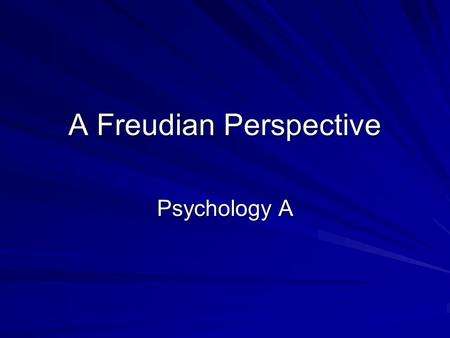Presentation on theme: “Theory and Practice of Counseling and Psychotherapy TENTH EDITION”— Presentation transcript:
1 Theory and Practice of Counseling and Psychotherapy TENTH EDITION
Gerald Corey Cengage Learning 
2 Psychoanalytic Therapy
CHAPTER 4 Psychoanalytic Therapy 
3 The Structure of Personality
THE ID —The Demanding Child Ruled by the pleasure principle THE EGO —The Traffic Cop Ruled by the reality principle THE SUPEREGO —The Judge Ruled by the moral principle Theory and Practice of Counseling and Psychotherapy – Chapter 4 (1) 
4 Conscious and Unconscious
What’s on the surface i.e., logic, reality Unconscious: What lies deep, below the surface i.e., drives, instincts Theory and Practice of Counseling and Psychotherapy – Chapter 4 (2) 
5 The Unconscious Clinical evidence for postulating the unconscious:
Dreams Slips of the tongue Posthypnotic suggestions Material derived from free-association and projective techniques Symbolic content of psychotic symptoms NOTE: consciousness is only a thin slice of the total mind Theory and Practice of Counseling and Psychotherapy – Chapter 4 (3) 
6 Anxiety Feeling of dread resulting from repressed feelings, memories, and desires Develops out of conflict among the id, ego, and superego to control psychic energy Three types of anxiety: Reality Anxiety Neurotic Anxiety Moral Anxiety Theory and Practice of Counseling and Psychotherapy – Chapter 4 (4) 
7 Ego-Defense Mechanisms (slide 1 of 2)
Are normal behaviors which operate on an unconscious level and tend to deny or distort reality Help the individual cope with anxiety and prevent the ego from being overwhelmed Have adaptive value if they do not become a style of life to avoid facing reality Theory and Practice of Counseling and Psychotherapy – Chapter 4 (5) 
8 Ego-Defense Mechanisms (slide 2 of 2)
Repression Denial Reaction Formation Projection Displacement Rationalization Sublimation Regression Introjection Identification Compensation Theory and Practice of Counseling and Psychotherapy – Chapter 4 (6) 
9 The Development of Personality
First year: ORAL STAGE Ages 1-3: ANAL STAGE Ages 3-6: PHALLIC STAGE Ages 6-12: LATENCY STAGE Ages 12-60: GENITAL STAGE Theory and Practice of Counseling and Psychotherapy – Chapter 4 (7) 
10 Erikson’s Psychosocial Perspective
Psychosocial stages: Erikson’s basic psychological and social tasks to be mastered from infancy through old age Erikson’s theory of development holds that psychosexual and psychosocial growth take place together During each psychosocial stage, we face a specific crisis that must be resolved in order to move forward Theory and Practice of Counseling and Psychotherapy – Chapter 4 (8) 
11 The Therapeutic Process
The goal is to make the unconscious conscious and strengthen the ego so behavior is based on reality The blank-screen approach fosters transference Achieving insight into problems and increasing awareness of ways to change helps clients gain control over their lives Pushing the client too rapidly or offering ill-timed interpretations will render the process ineffective Theory and Practice of Counseling and Psychotherapy – Chapter 4 (9) 
12 Psychoanalytic Phenomena
Transference occurs when the client reacts to the therapist as he or she did to an earlier significant other Countertransference is the reaction of the therapist toward the client that may interfere with objectivity Resistance is anything that works against the progress of therapy and prevents the production of unconscious material Theory and Practice of Counseling and Psychotherapy – Chapter 4 (10) 
13 Psychoanalytic Techniques (slide 1 of 2)
Maintaining the Analytic Framework Therapist uses a range of procedural and stylistic factors (e.g., analyst’s relative anonymity, consistency of meetings) Analysis of resistance Therapist helps clients become aware of reasons for their resistance so they can deal with them Analysis of transference Therapist uses this to elucidate client’s intrapsychic life Theory and Practice of Counseling and Psychotherapy – Chapter 4 (11) 
14 Psychoanalytic Techniques (slide 2 of 2)
Free Association Client reports immediately without censoring any feelings or thoughts Interpretation Therapist points out, explains, and teaches the meanings of whatever is revealed Dream Analysis Therapist uses the “royal road to the unconscious” to bring unconscious material to light Theory and Practice of Counseling and Psychotherapy – Chapter 4 (12) 
15 Application to Group Counseling
Group work provides a rich framework for working through transference feelings The group becomes a microcosm of members’ everyday lives Projections onto the leader and members are clues to unresolved intrapsychic conflicts that can be identified, explored, and worked through in the group Theory and Practice of Counseling and Psychotherapy – Chapter 4 (13) 
16 Jung’s Analytical Psychology (slide 1 of 2)
An elaborate explanation of human nature that combines ideas from history, mythology, anthropology, and religion Places central importance on psychological changes associated with midlife Achieving individuation—the harmonious integration of the conscious and unconscious aspects of personality—is an innate and primary goal Theory and Practice of Counseling and Psychotherapy – Chapter 4 (14) 
17 Jung’s Analytical Psychology (slide 2 of 2)
To become integrated, it is essential to accept our dark side, or shadow Dreams are aimed at integration and resolution; they contain messages from the collective unconscious, our source of creativity Images of universal experiences contained in the collective unconscious are called archetypes (the persona, the anima and animus, and the shadow) Theory and Practice of Counseling and Psychotherapy – Chapter 4 (15) 
18 Contemporary Psychodynamic Therapy (slide 1 of 2)
Object Relations Emphasizes attachment and separation Self Psychology Emphasizes how we use interpersonal relationships (self objects) to develop our own sense of self Theory and Practice of Counseling and Psychotherapy – Chapter 4 (16) 
19 Contemporary Psychodynamic Therapy (slide 2 of 2)
Relational Psychoanalysis Emphasizes the interactive process between client and therapist Brief Psychodynamic Therapy Applies the principles of psychodynamic theory and therapy to treating selective disorders within 10 to 25 sessions Theory and Practice of Counseling and Psychotherapy – Chapter 4 (17) 
20 Strengths from a Diversity Perspective
Erikson made significant contributions to how social and cultural factors affect people in many cultures over the life span This approach promotes intensive psychotherapy for therapists, which gives them insight into their countertransference, including biases and prejudices Theory and Practice of Counseling and Psychotherapy – Chapter 4 (18) 
21 Limitations from a Diversity Perspective
Based on upper- and middle-class values and may be cost prohibitive for many people Cultural expectations may lead clients to want more direction and structure from the professional More concerned with long-term personality reconstruction than with short-term problem solving Fails to address social, cultural, and political factors that oppress clients Theory and Practice of Counseling and Psychotherapy – Chapter 4 (19) 
22 Contributions of Psychoanalytic Approach (slide 1 of 2)
Helps therapists understand: Human behavior from a psychosexual perspective, which can be a powerful framework when paired with the psychosocial perspective That unfinished business can be worked through to provide a new ending to events that have restricted clients emotionally Theory and Practice of Counseling and Psychotherapy – Chapter 4 (20) 
23 Contributions of Psychoanalytic Approach (slide 2 of 2)
Helps therapists understand: The value of concepts such as unconscious motivation, the influence of early development, transference, countertransference, and resistance How the overuse of ego defenses keep clients from functioning effectively Theory and Practice of Counseling and Psychotherapy – Chapter 4 (21) 
24 Limitations of Psychoanalytic Approach (slide 1 of 2)
This approach may not be appropriate for all cultures or socioeconomic groups Deterministic focus does not emphasize current maladaptive behaviors Minimizes role of the environment Theory and Practice of Counseling and Psychotherapy – Chapter 4 (22) 
25 Limitations of Psychoanalytic Approach (slide 2 of 2)
Requires subjective interpretation Relies heavily on client fantasy Lengthy treatment may not be practical or affordable for many clients Theory and Practice of Counseling and Psychotherapy – Chapter 4 (23) 
Presentation on theme: “Theory and Practice of Counseling and Psychotherapy”— Presentation transcript:
1 Theory and Practice of Counseling and Psychotherapy
Chapter4: Psychoanalytic Therapy Theory and Practice of Counseling and Psychotherapy – Chapter 4 
2 Questions What kinds of connections do you have regarding psychoanalytic therapy? What is your thoughts and attitude regarding psychoanalytic therapy? Which parts of psychoanalytic therapy do you like or dislike? Why? Strengths and limitations of psychoanalytic therapy? Theory and Practice of Counseling and Psychotherapy – Chapter 4 
3 The Development of Personality
1. ORAL STAGE First year Related to later mistrust and rejection issues 2. ANAL STAGE Ages 1-3 Related to later personal power/control issues 3. PHALLIC STAGE Ages 3-6 Related to later sexual attitudes 4. LATENCY STAGE Ages 6-12 A time of socialization 5. GENITAL STAGE Ages 12-60 Sexual energies are invested in life Theory and Practice of Counseling and Psychotherapy – Chapter 4 
4 The Structure of Personality
THE ID — The Demanding Child (biological component, unconsciousness) Ruled by the pleasure principle THE EGO — The Traffic Cop (psychological component) Ruled by the reality principle THE SUPEREGO — The Judge (social component) Ruled by the moral principle Theory and Practice of Counseling and Psychotherapy – Chapter 4 
5 The Unconscious Clinical evidence for postulating the unconscious:
Dreams Slips of the tongue Posthypnotic suggestions Material derived from free-association Material derived from projective techniques Symbolic content of psychotic symptoms NOTE: consciousness is only a thin slice of the total mind Theory and Practice of Counseling and Psychotherapy – Chapter 4 
6 Ego-Defense Mechanisms
Are normal behaviors which operate on an unconscious level and tend to deny or distort reality Help the individual cope with anxiety and prevent the ego from being overwhelmed Have adaptive value if they do not become a style of life to avoid facing reality Theory and Practice of Counseling and Psychotherapy – Chapter 4 
7 View of human nature Deterministic:
Behavior is determined by irrational forces, unconscious motivation, and biological and instinctual drives. The first 6 years of life Libido: a source of motivation and energy Theory and Practice of Counseling and Psychotherapy – Chapter 4 
8 Therapeutic Goals Make the unconscious conscious Strengthen the ego
Explore past to increase self-understanding and gain insight Successful analysismodification of the individual’s personality. Theory and Practice of Counseling and Psychotherapy – Chapter 4 
9 Therapist’s function and role
Little self-disclosure to foster a transference relationship Help clients to achieve self-awareness, deal with anxiety, gain control, make unconscious conscious, and understand “why” for their symptoms Building relationship, listening, interpretation, and paying attention on resistances The role of clients’ readiness to change Theory and Practice of Counseling and Psychotherapy – Chapter 4 
10 Therapeutic Relationship
Working though the transference relationship Understanding the old pattern, connecting to current issues, and making new choices Reactions is not equal to transferences Contertransference reaction as a therapeutic tool to understand the world of the clients Theory and Practice of Counseling and Psychotherapy – Chapter 4 
11 Activity Free association activity
Write 5 minutes whatever come to your mind for the following topic 1. Free association about your dream OR 2. Pick up an animal (e.g., Bird) and then write any thoughts in you mind Any themes? Theory and Practice of Counseling and Psychotherapy – Chapter 4 
12 Psychoanalytic Techniques
Free Association Client reports whatever comes to mind Open doors to unconscious wishes, fantasies, conflicts, and motivation. Dream Analysis Therapist uses the “royal road to the unconscious” to bring unconscious material to light Theory and Practice of Counseling and Psychotherapy – Chapter 4 
13 Psychoanalytic Techniques
Interpretation Therapist points out, explains, and teaches the meanings of whatever is revealed Guidelines Close to conscious awareness Go only as deep as the client is able to go Point out resistance or defense before interpreting the emotion or conflict that lies beneath it Theory and Practice of Counseling and Psychotherapy – Chapter 4 
14 Transference and Countertransference
The client reacts to the therapist as he did to an earlier significant other This allows the client to experience feelings that would otherwise be inaccessible ANALYSIS OF TRANSFERENCE — allows the client to achieve insight into the influence of the past Countertransference The reaction of the therapist toward the client that may interfere with objectivity Theory and Practice of Counseling and Psychotherapy – Chapter 4 
15 Resistance Resistance Analysis of Resistance
Anything that works against the progress of therapy and prevents the production of unconscious material Analysis of Resistance Helps client become aware of the reasons for the resistance (e.g., avoiding pain or anxiety) Helps the client to see that canceling appointments, fleeing from therapy prematurely, etc., are ways of defending against anxiety These acts interfere with the ability to accept changes which could lead to a more satisfying life Theory and Practice of Counseling and Psychotherapy – Chapter 4 
16 Psych-dynamic Approach
Object Relations theory Self Psychology Interpersonal psychdynamic approach Core Conflictual Relationship Theme (CCRF)…… Theory and Practice of Counseling and Psychotherapy – Chapter 4 
17 Core Conflictual Relationship Theme
Wish What a person wants and wishes in relationships The Response of the Other (RO) how a person anticipates others will respond or how the others actually respond The Response of Self (RS) client’s affective. Cognitive, and behavioral response in relationship situations What’s your feelings? (affective) What’s your thoughts? (cognitive) What do you do? (behavioral) Theory and Practice of Counseling and Psychotherapy – Chapter 4 
18 Basic Psychological Need Satisfaction
Attachment Anxiety Attachment Avoidance Shame Loneliness Basic Psychological Need Satisfaction -.43*** -.32*** .20** .37*** -.46*** .05 -.75*** Depression .13*** .09*** .32*** -.64*** 
19 Psychoanalytic Therapy From a multicultural perspective
Contribution to multicultural counseling Help clients to build ego and cultural identity Help therapists become aware their own source of contertransference, bias, prejudices, and stereotypes. Limitations for multicultural counseling Cost, Upper- and middle-class values Ambigurity (vs. Asian prefers structured and concrete solution) Blame clients vs. blame external factors (social, cultural, or political factors) Theory and Practice of Counseling and Psychotherapy – Chapter 4 
20 Summary Contributions of Psychoanalytic approach
Limitations of psychoanalytic approach Case of Stan and Ruth Theory and Practice of Counseling and Psychotherapy – Chapter 4 




